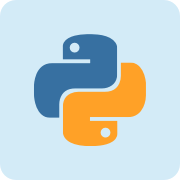Python参考手册
Python 日期和时间
Python 日期和时间
Python 日期和时间
Python 程序能用很多方式处理日期和时间,转换日期格式是一个常见的功能。
Python 提供了一个 time 和 calendar 模块可以用于格式化日期和时间。
时间间隔是以秒为单位的浮点小数。
每个时间戳都以自从1970年1月1日午夜(历元)经过了多长时间来表示。
Python 的 time 模块下有很多函数可以转换常见日期格式。如函数time.time()用于获取当前时间戳, 如下实例:
实例(Python 2.0+)
以上实例输出结果:
当前时间戳为: 1459994552.51
时间戳单位最适于做日期运算。但是1970年之前的日期就无法以此表示了。太遥远的日期也不行,UNIX和Windows只支持到2038年。
什么是时间元组?
很多Python函数用一个元组装起来的9组数字处理时间:
| 序号 | 字段 | 值 |
|---|---|---|
| 0 | 4位数年 | 2008 |
| 1 | 月 | 1 到 12 |
| 2 | 日 | 1到31 |
| 3 | 小时 | 0到23 |
| 4 | 分钟 | 0到59 |
| 5 | 秒 | 0到61 (60或61 是闰秒) |
| 6 | 一周的第几日 | 0到6 (0是周一) |
| 7 | 一年的第几日 | 1到366 (儒略历) |
| 8 | 夏令时 | -1, 0, 1, -1是决定是否为夏令时的旗帜 |
上述也就是struct_time元组。这种结构具有如下属性:
| 序号 | 属性 | 值 |
|---|---|---|
| 0 | tm_year | 2008 |
| 1 | tm_mon | 1 到 12 |
| 2 | tm_mday | 1 到 31 |
| 3 | tm_hour | 0 到 23 |
| 4 | tm_min | 0 到 59 |
| 5 | tm_sec | 0 到 61 (60或61 是闰秒) |
| 6 | tm_wday | 0到6 (0是周一) |
| 7 | tm_yday | 1 到 366(儒略历) |
| 8 | tm_isdst | -1, 0, 1, -1是决定是否为夏令时的旗帜 |
获取当前时间
从返回浮点数的时间戳方式向时间元组转换,只要将浮点数传递给如localtime之类的函数。
实例(Python 2.0+)
以上实例输出结果:
本地时间为 : time.struct_time(tm_year=2016, tm_mon=4, tm_mday=7, tm_hour=10, tm_min=3, tm_sec=27, tm_wday=3, tm_yday=98, tm_isdst=0)
获取格式化的时间
你可以根据需求选取各种格式,但是最简单的获取可读的时间模式的函数是asctime():
实例(Python 2.0+)
以上实例输出结果:
本地时间为 : Thu Apr 7 10:05:21 2016
格式化日期
我们可以使用 time 模块的 strftime 方法来格式化日期,:
time.strftime(format[, t])
实例演示:
实例(Python 2.0+)
以上实例输出结果:
2016-04-07 10:25:09 Thu Apr 07 10:25:09 2016 1459175064.0
python中时间日期格式化符号:
- %y 两位数的年份表示(00-99)
- %Y 四位数的年份表示(000-9999)
- %m 月份(01-12)
- %d 月内中的一天(0-31)
- %H 24小时制小时数(0-23)
- %I 12小时制小时数(01-12)
- %M 分钟数(00-59)
- %S 秒(00-59)
- %a 本地简化星期名称
- %A 本地完整星期名称
- %b 本地简化的月份名称
- %B 本地完整的月份名称
- %c 本地相应的日期表示和时间表示
- %j 年内的一天(001-366)
- %p 本地A.M.或P.M.的等价符
- %U 一年中的星期数(00-53)星期天为星期的开始
- %w 星期(0-6),星期天为星期的开始
- %W 一年中的星期数(00-53)星期一为星期的开始
- %x 本地相应的日期表示
- %X 本地相应的时间表示
- %Z 当前时区的名称
- %% %号本身
获取某月日历
Calendar模块有很广泛的方法用来处理年历和月历,例如打印某月的月历:
实例(Python 2.0+)
以上实例输出结果:
以下输出2016年1月份的日历:
January 2016
Mo Tu We Th Fr Sa Su
1 2 3
4 5 6 7 8 9 10
11 12 13 14 15 16 17
18 19 20 21 22 23 24
25 26 27 28 29 30 31
Time 模块
Time 模块包含了以下内置函数,既有时间处理的,也有转换时间格式的:
| 序号 | 函数及描述 |
|---|---|
| 1 | time.altzone 返回格林威治西部的夏令时地区的偏移秒数。如果该地区在格林威治东部会返回负值(如西欧,包括英国)。对夏令时启用地区才能使用。 |
| 2 | time.asctime([tupletime]) 接受时间元组并返回一个可读的形式为"Tue Dec 11 18:07:14 2008"(2008年12月11日 周二18时07分14秒)的24个字符的字符串。 |
| 3 | time.clock( ) 用以浮点数计算的秒数返回当前的CPU时间。用来衡量不同程序的耗时,比time.time()更有用。 |
| 4 | time.ctime([secs]) 作用相当于asctime(localtime(secs)),未给参数相当于asctime() |
| 5 | time.gmtime([secs]) 接收时间戳(1970纪元后经过的浮点秒数)并返回格林威治天文时间下的时间元组t。注:t.tm_isdst始终为0 |
| 6 | time.localtime([secs]) 接收时间戳(1970纪元后经过的浮点秒数)并返回当地时间下的时间元组t(t.tm_isdst可取0或1,取决于当地当时是不是夏令时)。 |
| 7 | time.mktime(tupletime) 接受时间元组并返回时间戳(1970纪元后经过的浮点秒数)。 |
| 8 | time.sleep(secs) 推迟调用线程的运行,secs指秒数。 |
| 9 | time.strftime(fmt[,tupletime]) 接收以时间元组,并返回以可读字符串表示的当地时间,格式由fmt决定。 |
| 10 | time.strptime(str,fmt='%a %b %d %H:%M:%S %Y') 根据fmt的格式把一个时间字符串解析为时间元组。 |
| 11 | time.time( ) 返回当前时间的时间戳(1970纪元后经过的浮点秒数)。 |
| 12 | time.tzset() 根据环境变量TZ重新初始化时间相关设置。 |
Time模块包含了以下2个非常重要的属性:
| 序号 | 属性及描述 |
|---|---|
| 1 | time.timezone 属性time.timezone是当地时区(未启动夏令时)距离格林威治的偏移秒数(>0,美洲;<=0大部分欧洲,亚洲,非洲)。 |
| 2 | time.tzname 属性time.tzname包含一对根据情况的不同而不同的字符串,分别是带夏令时的本地时区名称,和不带的。 |
日历(Calendar)模块
此模块的函数都是日历相关的,例如打印某月的字符月历。
星期一是默认的每周第一天,星期天是默认的最后一天。更改设置需调用calendar.setfirstweekday()函数。模块包含了以下内置函数:
| 序号 | 函数及描述 |
|---|---|
| 1 | calendar.calendar(year,w=2,l=1,c=6) 返回一个多行字符串格式的year年年历,3个月一行,间隔距离为c。 每日宽度间隔为w字符。每行长度为21* W+18+2* C。l是每星期行数。 |
| 2 | calendar.firstweekday( ) 返回当前每周起始日期的设置。默认情况下,首次载入 calendar 模块时返回 0,即星期一。 |
| 3 | calendar.isleap(year) 是闰年返回 True,否则为 False。 >>> import calendar >>> print(calendar.isleap(2000)) True >>> print(calendar.isleap(1900)) False |
| 4 | calendar.leapdays(y1,y2) 返回在Y1,Y2两年之间的闰年总数。 |
| 5 | calendar.month(year,month,w=2,l=1) 返回一个多行字符串格式的year年month月日历,两行标题,一周一行。每日宽度间隔为w字符。每行的长度为7* w+6。l是每星期的行数。 |
| 6 | calendar.monthcalendar(year,month) 返回一个整数的单层嵌套列表。每个子列表装载代表一个星期的整数。Year年month月外的日期都设为0;范围内的日子都由该月第几日表示,从1开始。 |
| 7 | calendar.monthrange(year,month) 返回两个整数。第一个是该月的星期几的日期码,第二个是该月的日期码。日从0(星期一)到6(星期日);月从1到12。 |
| 8 | calendar.prcal(year,w=2,l=1,c=6) 相当于 print calendar.calendar(year,w=2,l=1,c=6)。 |
| 9 | calendar.prmonth(year,month,w=2,l=1) 相当于 print calendar.month(year,month,w=2,l=1) 。 |
| 10 | calendar.setfirstweekday(weekday) 设置每周的起始日期码。0(星期一)到6(星期日)。 |
| 11 | calendar.timegm(tupletime) 和time.gmtime相反:接受一个时间元组形式,返回该时刻的时间戳(1970纪元后经过的浮点秒数)。 |
| 12 | calendar.weekday(year,month,day) 返回给定日期的日期码。0(星期一)到6(星期日)。月份为 1(一月) 到 12(12月)。 |
其他相关模块和函数
在Python中,其他处理日期和时间的模块还有:
- datetime模块
- pytz模块
- dateutil模块
| Python 日期和时间 |
|---|

Python 是一种面向对象的解释型计算机程序设计语言,由荷兰人 Guido van Rossum 于1989年发明,第一个公开发行版发行于1991年。 Python 是纯粹的自由软件, 源代码和解释器 CPython 遵循 GPL 协议。Python 语法简洁清晰,特色之一是强制用空白符( white space )作为语句缩进。
| 主页 | https://www.python.org/ |
| 源码 | https://github.com/python/cpython |
| 版本 | 2.7 |
| 发布版本 | 2.7.13 |
 加载中,请稍侯......
加载中,请稍侯......